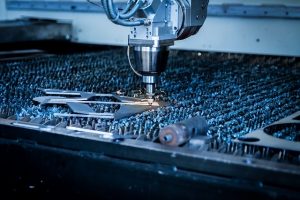
Not all cutting processes involve the use of a physical cutting tool. While lathes and milling machines do, in fact, use a physical cutting tool, laser machines do not. Laser cutting is a cutting process in which a machine projects a focused beam of light onto a workpiece to selectively cut in the workpiece in the desired area of areas.
The extreme heat produces by the laser is able to slice through the workpiece, resulting in a new shape and size. There are two primary types of laser cutting processes, though: CO2 and Nd. So, what’s the difference between CO2 and Nd laser cutting?
What Is CO2 Laser Cutting?
CO2 laser cutting is characterized by its use of carbon dioxide (CO2). The CO2 is responsible for propagating the laser’s infrared light. During CO2 laser cutting, electricity flows through a cylinder filled with CO2. There are mirrors on the ends of this cylinder that project the infrared light down onto the workpiece for cutting. While CO2 laser requires CO2, the cylinders used in this process may contain other gases as well, including hydrogen, helium and nitrogen. Regardless, all CO2 laser cutting processes are performed with CO2. CO2 laser cutting is an all-around versatile process that supports a wide range of cutting applications.
What Is Nd Laser Cutting?
Nd laser cutting, on the other hand, uses neodymium to propagate the infrared light produced by the laser. Unlike CO2 laser cutting, it doesn’t use CO2 gas. Instead, it uses neodymium to propagate the laser’s infrared light. Nd laser cutting is typically used in cutting applications that require large amounts of energy. It’s also able to support boring applications as well, which one of the characteristics that distinguish it from CO2 laser cutting.
What About Nd-YAG Laser Cutting?
A third type of laser cutting process is Nd-YAG. An acronym for “neodymium yttrium-aluminium-garnet,” Nd-YAG is essentially a more powerful version of ND laser cutting. It’s able to output even more energy than ND laser cutting. And with its exceptionally high energy output, Nd-YAG can cut through the toughest materials. In addition to cutting, Nd-YAG supports boring and welding applications.
CO2 and Nd laser cutting aren’t the same. The former uses CO2 gas, whereas the latter uses neodymium. As a result, they have different characteristics when used to cut or otherwise physically manipulate workpieces.
